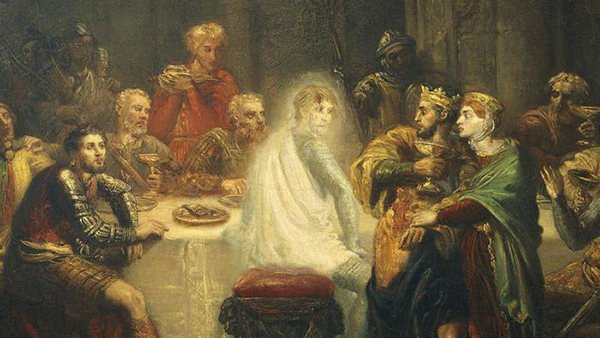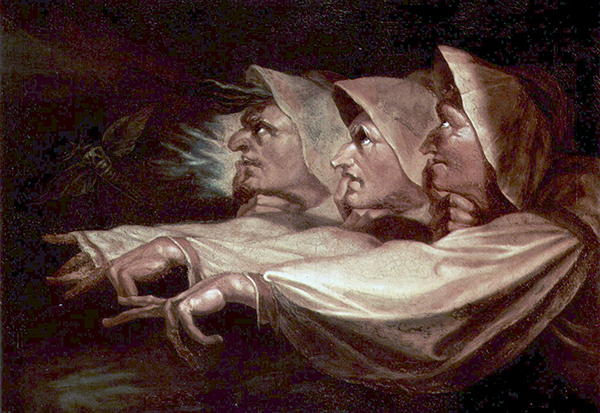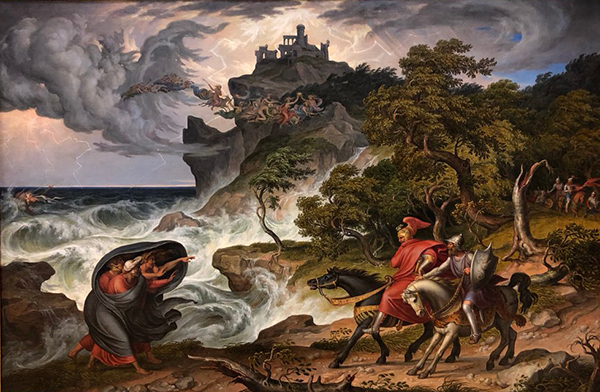
Act III Lessons
Complete text of play
Audio recording of Act III
Lesson 9: Act 3.1 and 3.2: In this lesson, students read and analyze Act 3.1 of Macbeth, in which Banquo airs his suspicions of Macbeth’s foul play and Macbeth hires a troupe of murderers to kill Banquo and his son Fleance. Students analyze how specific details in this scene further develop a central idea in the text.
- Classwork - Listen to a masterful reading of Act 3.1 of Macbeth, and pay attention to Shakespeare’s use of figurative language.
- QuickWrite - How do key details in this scene further develop a central idea?
- Homework - Listen to a masterful reading of Macbeth Act 3.2 and pay attention to how Lady Macbeth and Macbeth interact and to each character’s state of mind.
Lesson 10: Act 3.3 and 3.4: In this lesson, students read and analyze Act 3.2 of Macbeth, in which Macbeth and Lady Macbeth discuss the emotional toll their nefarious deeds have taken on them. This scene also marks the first clear sign that Macbeth and Lady Macbeth are advancing towards their tragic end.
- Classwork - listen to a masterful reading of Macbeth Act 3.3 and pay attention to how Lady Macbeth and Macbeth interact and to each character’s state of mind.
- QuickWrite - How do the interactions between Macbeth and Lady Macbeth further develop a central idea?
- Homework - Read Act 3.4 and answer the questions on the Homework Scaffolding Tool: Macbeth Act 3.4.
Lesson 11: Act 3.5 and 3.6: In this lesson, students continue their work with Macbeth, reading Act 3.4, in which Macbeth sees Banquo’s ghost at a feast, but nobody else does. Students focus on the development of central ideas in this scene (such as appearance versus reality or imbalance and disorder).
- Classwork - Listen to a masterful reading of Act 3.5 of Macbeth, and listen for details that develop the mood of the scene.
- QuickWrite - Analyze the impact of Shakespeare’s use of figurative language on the mood of this scene.
- Homework - Read Act 3.6 and answer the questions on the Homework Scaffolding Tool: Macbeth Act 3.6.
- Homework - Complete an analysis of Act 3, using the Act Synopsis and Analysis Tool.

Act IV Lessons
Complete text of play
Audio recording of Act IV
Lesson 12: Act 4.1: In this lesson, students continue their work with Macbeth, reading Act 4.1, in which Macbeth meets with the Three Witches, who present him with apparitions that tell him of the future. Working in small groups, students focus on the development of plot in this scene.
- Classwork - listen to a masterful reading of Macbeth Act 4.1 and focus on the mood of the passage.
- QuickWrite - How do the Witches’ interactions with Macbeth advance the plot?
Lesson 13: Act 4.2: In this lesson, students read Act 4.2 of Macbeth, in which Lady Macduff laments her husband’s decision to flee Scotland instead of defending his family, and in which she and her children are slain by Murderers commissioned by Macbeth. Students explore how Shakespeare uses figurative language to develop a central idea.
- Classwork - Listen to a masterful reading of Act 4.2 of Macbeth, and pay attention to Shakespeare’s use of figurative language.
- QuickWrite - How does Shakespeare use specific details to develop a central idea in this scene?
- Homework - Preview Act 4.3, lines 1–158 (from “Let us seek out some desolate shade” to “’Tis hard to reconcile”). Box any unfamiliar words and look up their definitions in either the explanatory notes or a dictionary. Choose the definition that makes the most sense in the context, and write a brief definition above or near the word in the text. Also, respond to the following prompts in writing:
- What words or phrases does Macduff use to describe Macbeth?
- What words or phrases does Malcolm use to describe Macbeth?
Lesson 14: Act 4.3: In this lesson, students read Act 4.3, lines 1–158 of Macbeth, in which Macduff tries to convince Malcolm to join him and take Macbeth’s crown. Malcolm suspects Macbeth has sent Macduff to trick him, so he tests Macduff’s sincerity before he agrees to join Macduff. Students analyze how Shakespeare uses Macduff and Malcolm’s interaction to develop Macbeth’s character.
- Classwork - listen to a masterful reading of Macbeth Act 4.3, lines 1–158 of Macbeth (from “Let us seek out some desolate shade” to “’Tis hard to reconcile”). and pay attention to how Malcolm and Macduff talk about Macbeth.
- QuickWrite - How does Shakespeare further develop Macbeth through the interaction between Malcolm and Macduff?
- Homework - Read Act 4.3 and answer the questions on the Homework Scaffolding Tool: Macbeth Act 4.3.
Lesson 15: Act 4.3: In this lesson, students read Act 4.3, lines 200–282 of Macbeth, in which Ross tells Macduff of his family’s murder. Macduff and Malcolm resolve to attack Macbeth. Students analyze the effect of Shakespeare’s structural choice to show the audience the death of Macduff’s family before it is revealed to Macduff.
- Classwork - listen to a masterful reading of Act 4.3, lines 200–282 of Macbeth (from “What’s the newest grief? / That of an hour’s age doth hiss the speaker” to “The night is long that never finds the day”). Pay attention to Shakespeare’s structural choices as Macduff learns of his family’s death.
Analyze the effect of Shakespeare’s structural choice in revealing to the audience and to Macduff that his family has been murdered.
- QuickWrite - Analyze the impact of Shakespeare’s use of figurative language on the mood of this scene.
- Homework - Complete an analysis of Act 4, using the Act Synopsis and Analysis Tool.

Act V Lessons
Complete text of play
Audio recording of Act V
Lesson 16: Act 5.1: In this lesson, students read Act 5.1 of Macbeth, in which a Gentlewoman and the Macbeth’s Doctor watch Lady Macbeth sleepwalk and lament over the murders she and Macbeth have committed. Students analyze how Shakespeare advances a central idea by showing Lady Macbeth’s descent into madness.
- Classwork - listen to a masterful reading of Macbeth Act 5.1. Pay attention to how Shakespeare develops the character of Lady Macbeth in this scene.
- QuickWrite - Analyze how Shakespeare refines a central idea through his development of the character of Lady Macbeth in this scene.
- Homework - Select an excerpt from Macbeth for an interpretive dramatic reading. Review the Interpretive Dramatic Reading Performance Checklist.
Lesson 17: Act 5.2 and 5.3: In this lesson, students read and analyze Macbeth Act 5.2 and 5.3, in which the thanes desert Macbeth, who seeks assurances in the Witches’ prophecy and who receives updates from the Doctor on Lady Macbeth’s illness. Students explore Shakespeare’s use of multiple perspectives and character interactions to develop Macbeth in these scenes by engaging in a collaborative jigsaw discussion.
- Classwork - listen to a masterful reading of Macbeth Act 5.2 and 5.3 (from “The English power is near, led on by Malcolm” to “Profit again should hardly draw me here”). Listen for how Shakespeare develops Macbeth in these scenes.
- QuickWrite - How do the character interactions in these scenes further develop the character of Macbeth?
- Homework - Practice reading your selected interpretive dramatic reading text excerpt aloud.
Lesson 18: Act 5.4, 5.5, and 5.6: In this lesson, students read and analyze Macbeth Act 5.4, 5.5, and 5.6, in which both sides prepare for battle and Macbeth learns of Lady Macbeth’s death. Students explore Shakespeare’s use of figurative language to develop the character of Macbeth in these scenes by engaging in an evidence-based discussion. Students also prepare for the interpretive dramatic reading activity in 10.4.2 Lesson 20 through a group discussion in which they rehearse their selected excerpt and select an interpretive dramatic reading technique.
- Classwork - listen to a masterful reading of Macbeth Act 5.4, 5.5, and 5.6. Listen for how Shakespeare uses figurative language in these scenes.
- QuickWrite - How does Shakespeare’s use of figurative language further develop the character of Macbeth in these scenes?
- Homework - Practice reading your selected interpretive dramatic reading text excerpt aloud.
Lesson 19: Act 5.7 and 5.8: In this lesson, students read and analyze Macbeth, Act 5.7 and 5.8, in which Macbeth engages in battle with Malcolm and his thanes and is defeated and killed by Macduff, who, Macbeth learns, was not born of woman but was born prematurely by cesarean section. Students explore the elements of tragedy and analyze Macbeth as an example of the genre through a jigsaw discussion. Students also work in groups to rehearse their interpretive dramatic reading performance for 10.4.2 Lesson 20.
- Classwork - Listen to a masterful reading of Act 5.7 of Macbeth, and listen for the elements of classical tragedy in these scenes.
- QuickWrite - How does Shakespeare unfold and develop an element of tragedy in Act 5.7 and 5.8?
- Homework - Complete an analysis of Act 4, using the Act Synopsis and Analysis Tool.
- Homework - Rehearse your selected interpretive dramatic reading text excerpt aloud.
Lesson 20: In this lesson, students use interpretive dramatic reading techniques to interpret self-selected scenes from Shakespeare’s Macbeth. After meeting in their small groups for a final rehearsal, students present their interpretive dramatic reading performances, either to a group of peers or to the whole class, who evaluate the performances and/or digitally record for future teacher review. Finally, students complete a self-evaluation of their group performances.
- Classwork - Performances of interpretive dramatic readings
- Homework - Reflect on your interpretive dramatic reading performance and complete the Interpretive Dramatic Reading Self-Assessment Checklist. Also, review Macbeth, along with all notes and annotations, to gather evidence to support an argument about which character is primarily responsible for the tragedy of Macbeth. Use the Macbeth Character Responsibility Tool to begin gathering evidence to respond to the End-of-Unit Assessment prompt:
- Select a central character from Macbeth. Write an argument about how this character is primarily responsible for the tragedy. Support your claims using evidence that draws on character development, interactions, plot, and/or central ideas.
Lesson 21: In this lesson, students prepare for their End-of-Unit written and oral assessments by considering Macbeth in its entirety and beginning to form an argument in response to the question of which character bears primary responsibility for the tragedy. Student learning is assessed through a Quick Write in response to the following prompt: Which character bears the most responsibility for the tragedy of Macbeth? Use reasoning to support the claim and provide one piece of evidence to support your choice and strengthen your reasoning.
- Classwork - Complete the Macbeth Argument Outline Tool to help guide your End-of-Unit Assessment. Record your central claim in the top box of the tool, review your text, notes, and annotations to collect textual evidence from Macbeth that supports your central claim. Then use this evidence to establish at least three supporting claims. You should then complete the Reasoning portion of the tool, explaining how the evidence you selected supports your claims.
- Homework - Use the End-of-Unit Text Analysis Rubric and Checklist to review the argument you have outlined for the End-of-Unit Assessment.
Lesson 22: In this End-of-Unit Assessment, students craft a formal, multi-paragraph essay presenting an argument in response to the question of which character bears the most responsibility for the tragedy of Macbeth. Students review their annotated text, lesson Quick Writes, discussion notes, homework notes, and tools to organize their ideas. Students then develop their arguments with supporting claims based on relevant evidence and valid reasoning. For homework students either prepare for a presentation of their argument or reread two scenes from Act 1 in Macbeth that feature the Witches, depending on whether they move on to 10.4.2 Lesson 23a or 10.4.2 Lesson 23.
- End-of-Unit Assessment - Because it is a formal writing task, the 10.4.2 End-of-Unit Assessment should include an introductory statement that presents a central claim, well-organized supporting claims and counterclaims with supporting evidence and clear reasoning, and a concluding statement that articulates the importance of the argument. Remind students to use domain-specific vocabulary, as well as proper grammar, capitalization, punctuation, and spelling to achieve a formal style and objective tone. Remind students as they write to refer to their notes, tools, and annotated text from previous lessons.
- QuickWrite - How do key details in this scene further develop a central idea?
- Homework - Review your Macbeth Argument Outline Tool and the End-of-Unit Speaking and Listening Rubric and Checklist. Practice presenting your short (less than five minutes) argument orally.
Lesson 23a: In this optional lesson students present their arguments from the previous lesson as oral presentations to small groups of peers. After discussing the factors that contribute to a successful oral presentation, students share their arguments about which character from Macbeth is primarily responsible for the tragedy, using evidence to support claims. Student learning is demonstrated through digitally recorded individual presentations.

Lesson 23: Interpreting Literature Visually - In this lesson, students prepare to consider treatments of Macbeth in the visual arts through a variety of activities. Students consider how Act 1.1 and 1.3 develop characters, plot, and central ideas before discussing how the Witches are depicted in the visual arts, focusing on “Macbeth and The Witches,” by Joseph Anton Koch. Students analyze a second painting, Henry Fuseli’s “The Three Witches,” as part of their assessment.
- Activity 1 - Students use Macbeth Style Tool to analyze how the Witches are depicted in “Macbeth and The Witches,” by Joseph Anton Koch pictured above (click for larger image.)
- Activity 2 - Students analyze a second painting, Henry Fuseli’s “The Three Witches”, pictured on the right (click for larger image.)
- QuickWrite - Analyze how Henry Fuseli draws on and transforms the Witches from Shakespeare’s Macbeth. What does Fuseli emphasize or omit in his treatment of these characters?
- Homework - Conduct a brief search to find five interesting facts about either Akira Kurosawa or samurai films to share with the class.
Lesson 24: Interpreting Literature Visually - In this lesson, students view and analyze Throne of Blood, Akira Kurosawa’s 1957 film adaptation of Macbeth, in order to compare Kurosawa’s presentation of the opening scenes (the first 20:09 minutes of the film) to Act 1.1 through Act 1.3 of the original play. Students consider what is absent or changed in the film version of the opening scenes. They then explore how Kurosawa’s representation might influence their understanding of Shakespeare’s setting of these scenes and introduction of the characters. As they view the film, students record their observations on the Kurosawa Film Viewing Tool. Students use their observations as the basis for an evidence-based discussion about how Kurosawa develops and interprets the first three scenes of Macbeth through character development, and the use of setting and cinematic choices.
- Classwork - Students view the opening of Throne of Blood and record their observations on the Kurosawa Film Viewing Tool.
- Homework - Write a paragraph in response to the following prompt: What does Kurosawa choose to emphasize or omit in his treatment of the opening three scenes of Macbeth? Analyze the impact of these choices.
- Optional Extension Homework - Respond in writing to the following question using the Throne of Blood Homework Tool.
- Reread the Witches' dialogue from Act 1.3, lines 1–38 of Macbeth and the lyrics of the spirit's song from Throne of Blood and analyze how these two texts develop mood.
Lesson 25: In this lesson, students view and analyze the 2018 Royal Shakespeare Company (RSC) production of Macbeth (00:00-14:55) in order to compare the film version of Acts 1.1 through 1.3 to the original text. Students consider the staging of the film version in the opening scenes. They then explore how the RSC’s directorial choices might influence their understanding of Shakespeare’s setting of these scenes and introduction of the characters. As they view the film, students record their observations on the RSC Film Viewing Tool. Students use their observations as the basis for an evidence-based discussion of character development, setting, and cinematic choices in the first three scenes of the RSC production of Macbeth.
- Classwork - Students view the opening of RSC's Macbeth and record their observations on the RSC Film Viewing Tool.
- QuickWrite - Analyze how the RSC production develops and transforms the first three scenes of Macbeth.
- Homework - Write a paragraph in response to the following prompt:
- Analyze the impact of the directors’ choice of setting in Kurosawa’s Throne of Blood and the RSC production of Macbeth.
Lesson 26: In this lesson students review how both Kurosawa’s hero and the RSC’s Macbeth interact with supernatural powers, exploring the significance of how directorial choices emphasize different elements of a drama. After a brief review of transitional words and phrases, domain-specific vocabulary, and using a formal style, students revise short writing pieces from previous lessons to practice using these writing skills. Students then participate in a film discussion of the Royal Shakespeare Company’s film production of Macbeth and Akira Kurosawa’s Throne of Blood. The lesson concludes as students use the revised writing pieces, as well as notes from the film discussion and earlier lessons, as the basis for a new Quick Write that requires students to analyze the interactions between the main characters and the Witch(es) in Kurosawa’s adaptation and the Royal Shakespeare’s 2011 version of Macbeth.
- QuickWrite - Analyze the interactions between the main characters and the Witch(es) in Kurosawa’s adaptation and the RSC’s 2011 version of Macbeth. What is emphasized or absent in each treatment?